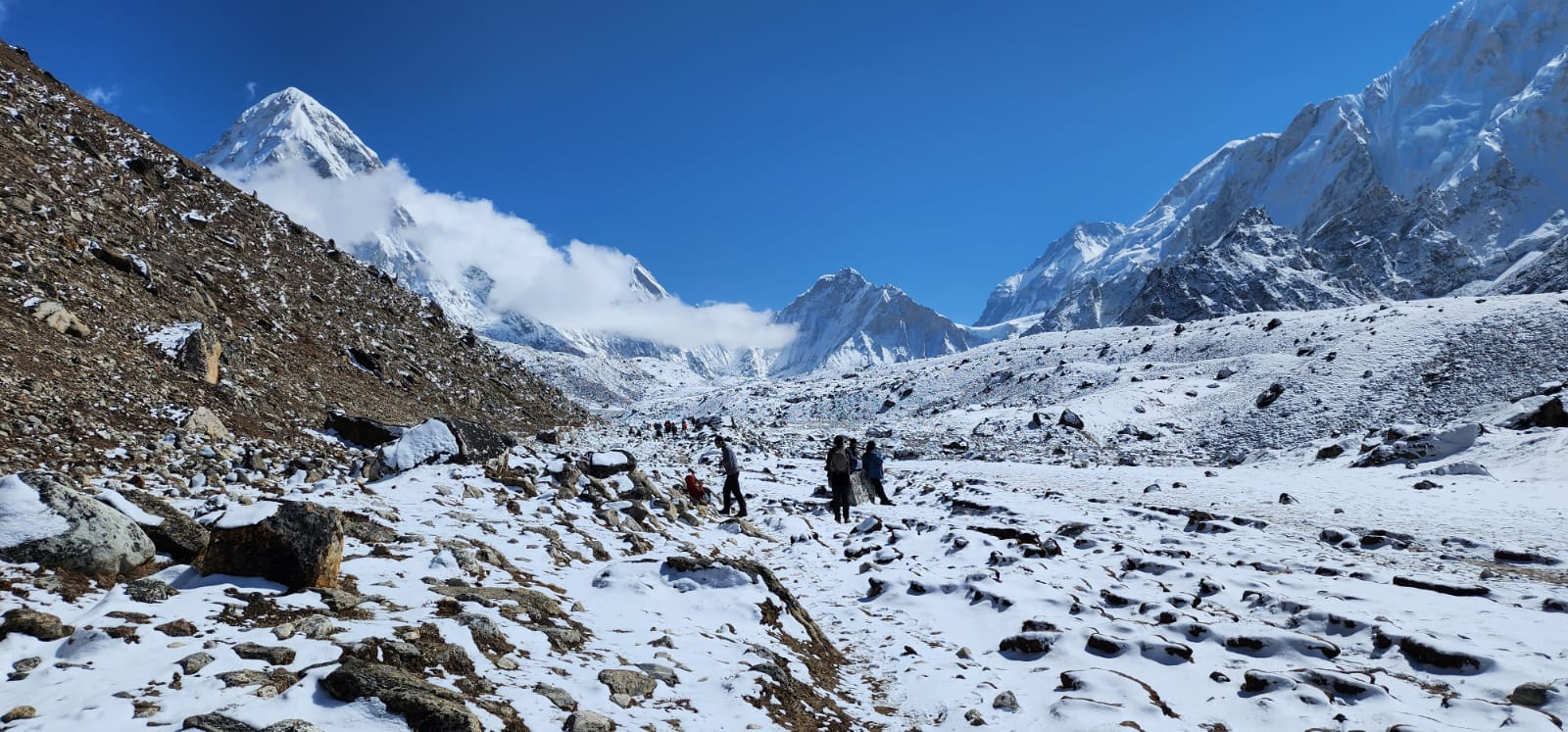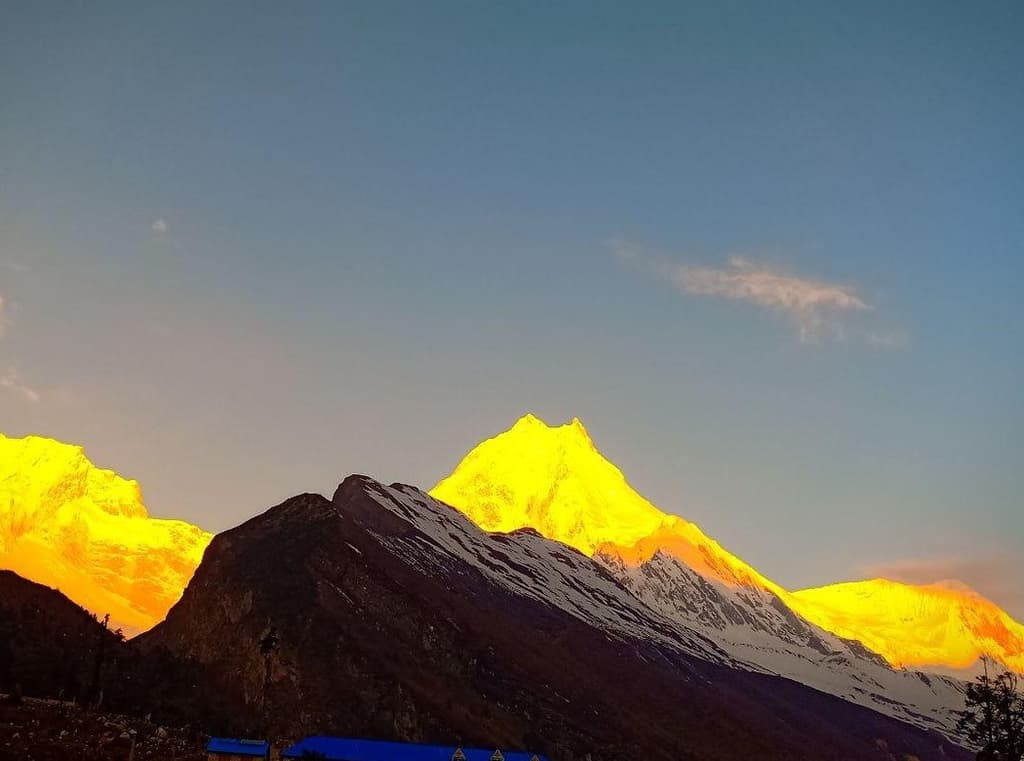Everest Base Camp Trek is one of the nostalgic trekking packages in Nepal. While many trekkers find themselves called by this trek, there is a thing that they should acknowledge about the Everest Region. As we all know, Everest Region is a hazardous location featuring crevasses, rocky and rugged terrains, steep ridges, and an uphill geographic location; it pushes trekkers to prepare with all they have to surf around the region safely. This is why we created the packing list for Everest Base Camp Trek .
Trekkers must consider packing weather-friendly clothes, footwear, camping gear, hygiene products, and more. Remember that only suitable and favorable equipment will ensure your safety. Trekkers must research the general info about Everest's location, weather conditions, landscapes, time of year, length of the itinerary, and activities before embarking on the Everest Base Camp Trek. Besides, hiring porters is another must-prepare thing as you cannot carry all your gear by yourself. You need help carrying them to use them during the trek.
Here in this blog, we will cover all the essential packing lists for Everest Base Camp Trek. We will discuss why you need any clothes, gear, or backpack and what makes it worth it. We recommend you pack your essentials wisely to conquer the EBC Trek safely.
Clothing for Different Weather Conditions on the Everest Base Camp Trek
Base Layers (long-sleeve thermal tops and bottoms)
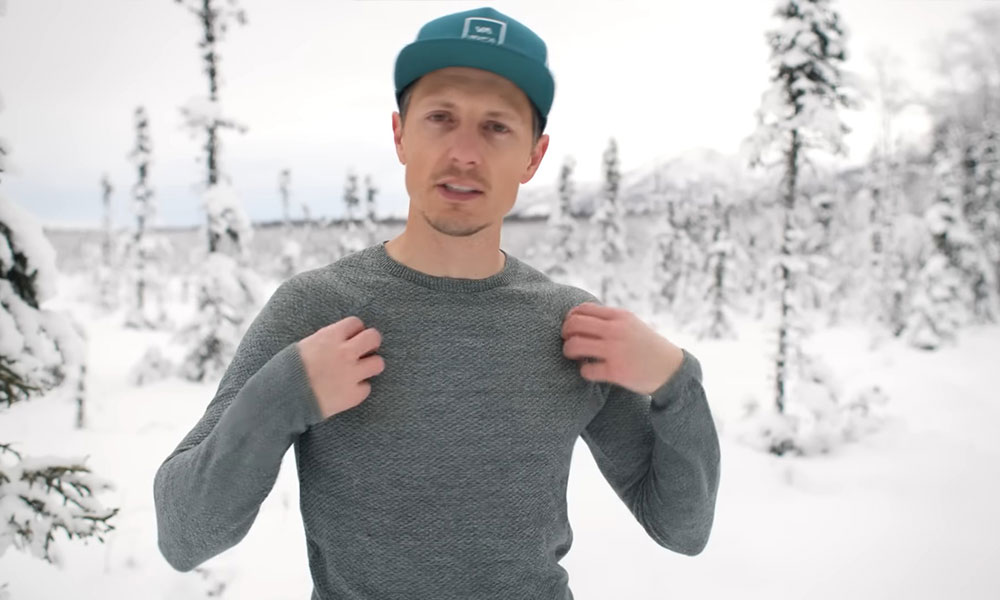
Trekkers must confirm that they have comfortable base layers before embarking on Everest Base Camp Trek. These outfits come as one of the prioritized packing items for the trek. Base Layers such as thermal underwear and layer tops should be in your backpack to make yourself warm and safe at the high altitude locations of the EBC region.
These base layers provide an extra layer of insulation, ensuring heat retention. Trekkers should consider wearing wool or synthetic materials like polyester or nylon-made base layers.
Hiking Pants
Hiking pants are another crucial outfit that should be packed for this adventurous trek. Remember, you should not compromise their comfort and flexibility when you pack hiking pants. Trekkers have to walk for over 6 to 7 hours each day on rugged routes and rocky terrains, and their outfits adversely impact cherishing the trek. So having warm, flexible, durable, and breathable hiking pants are mandatory.
Fleece or Down Jacket | Waterproof Jacket and Pants
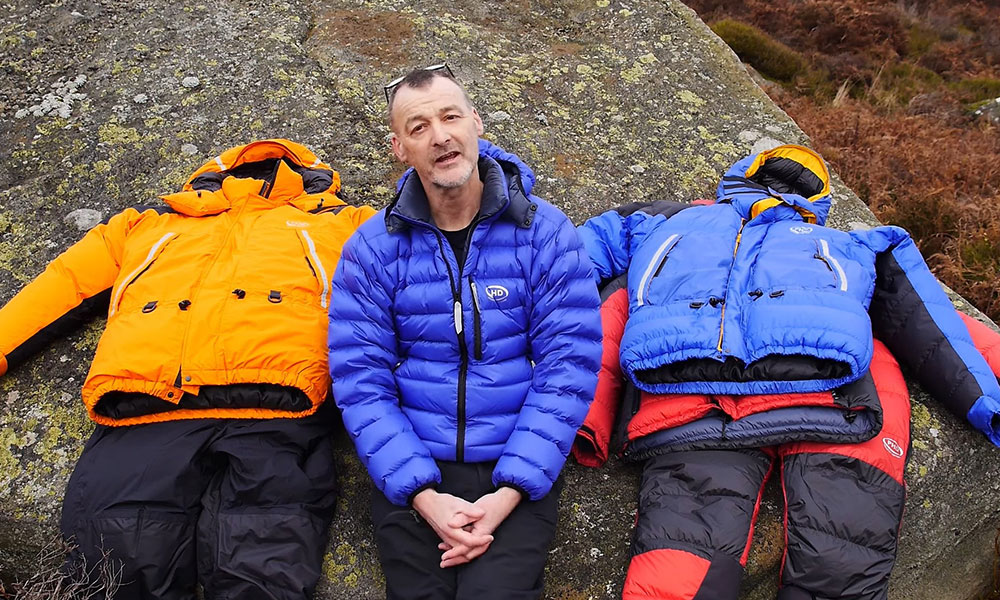
Everest Region is known for its freezing temperature. And if you are trekking during the winter season, your journey might be even more complicated and challenging. Wearing a fleece and jacket will ensure heat retention in your body. But remember, when you pack these jackets, they should be waterproof and windproof to resist sharp winds and potential raindrops and dews.
Hiking Socks
You need to ensure your feet are okay while hiking for a long time on an uneven trail. Hiking socks are what make your journey comfortable. These socks go in your feet inside hiking boots, which makes your feet okay and sturdy to walk through the ups and downs of the hill. These socks should be warm, breathable, and comfortable, making your hike enjoyable.
Warm Hat and Gloves
Warm hats are generally needed to keep your head warm from the freezing temperature of the Everest Region. During the daytime, the temperature will go around 5 to 10 Degrees Celsius, while it might drastically fall to -5 Degrees Celsius at night. So to keep your head warm and avoid health hazards like HAPE, HACE, and swollen face, trekkers must pack warm hats.
*Gloves are also needed for the same mechanism to protect your hands from frostbite.
Sturdy Trekking Boots for the EBC Trail
Hiking Boots (make sure they are broken in before the trek)
.jpg)
Completing the Everest Base Camp Trek without proper hiking boots is almost impossible. As we all know, the EBC Trail comprises rocky terrain, treacherous moraines, and rugged landscapes; trekkers must pack a pair of sturdy hiking boots to navigate safely and easily.
Sturdy hiking boots provide a strong grip on the ground, which is essential on the Everest Base Camp trail. These boots can even provide steadiness during the monsoon season when there is a chance of heavy rainfall and slippery routes. In addition, it also saves your feet from frostbite and other cold-related issues.
Camp Shoes (such as flip-flops or sandals)
While you stay at a tea house and camps, hiking boots, and sandals will not work. Wearing sandals is dangerous since it does not protect your feet from the cold. And hiking boots are uncomfortable to wear as you need to sleep and be engaged in other activities like cooking and walking around the places.
Camp Shoes will serve you best in comfort, convenience, and safety.
Staying Hydrated: Water Bottles, Bladders, and Purification Options
Water Bottles or Hydration Bladder

Staying hydrated is a primary mantra while embarking on a trek. So, carrying water bottles and hydration bladders is essential while setting up your Everest Base Camp Trek packing list. While trekkers traverse high-altitude locations like Kala Patthar, Gorakshep, Dingboche, and Tengboche, they are more likely to get altitude sickness and other related illnesses. Staying hydrated will help trekkers to get rid of potential altitude sickness. Drinking enough water and fluids will help the human body circulate blood flow. So why not carry water bottles and a hydration bladder to avoid danger?
Water Purification Tablets or Filter
When you travel to EBC, only natural water sources are in the route. You can get safe drinking water only in tea houses and guest houses, but there are no other ways to get safe drinking water when you are on the way. So, you can use water purification tablets and filters to filter the stream waters and drinks.
These tablets release chlorine or iodine into the water, which kills harmful bacteria and viruses. But this process has both positive and negative side effects. While it cleans the water, it also leaves a bad aftertaste, which might not be preferable to all the trekkers.
Backpack and Trekking Poles for the Hike
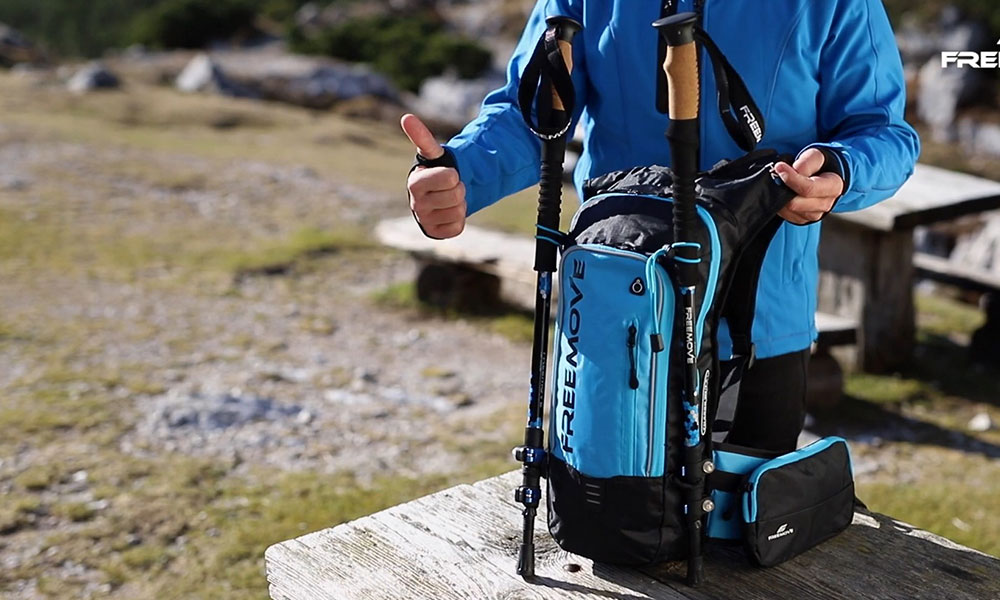
Daypack (20-30 liters)
All the trekkers need a daypack to carry the items like water, snacks, a camera, and other essentials during the Everest Base Camp Trek. Remember, your daypack should have a minimum storage capacity of 20 to 30 liters to fit all the necessary items.
Generally, daypacks are heavy than other items, so you should consider purchasing polyester or strong nylon backpacks. Hire a porter, so you should not deal with carrying issues during the long trek.
Duffel Bag or Backpack (around 60 liters)
The main reason to carry a duffel bag is to keep your belongings safe and unharmed. Items like gadgets, extra clothes, and trekking gear go inside duffel bags. While preparing the Packing List for Everest Base Camp, you should be mindful of the Duffel Bag's capacity, which should be around 60 liters at minimum. This also goes with porters, so you should not worry about carrying large backpacks during your EBC Trek.
Rain Cover for Your Backpack
Pack a rain cover to keep your backpack unharmed by rain and dew. Raincovers are mostly water and windproof, so you need not worry about your items and equipment getting wet while you embark on the Everest Base Camp Trek.
Trekking Poles
Trekking Poles are another crucial elements you should consider for your packing list for Everest Base Camp Trek. These items help you gain steadiness and balance your body in the steep and uphill trails of EBC. We all know our body gets exhausted as we walk for 6 to 7 hours daily. And when the altitude increases, it becomes more challenging for our body to get energized and steady. Here, trekking poles come with a great advantage for trekkers.
Essential Camping Gear: Tent, Sleeping Bag, Mat, Headlamp
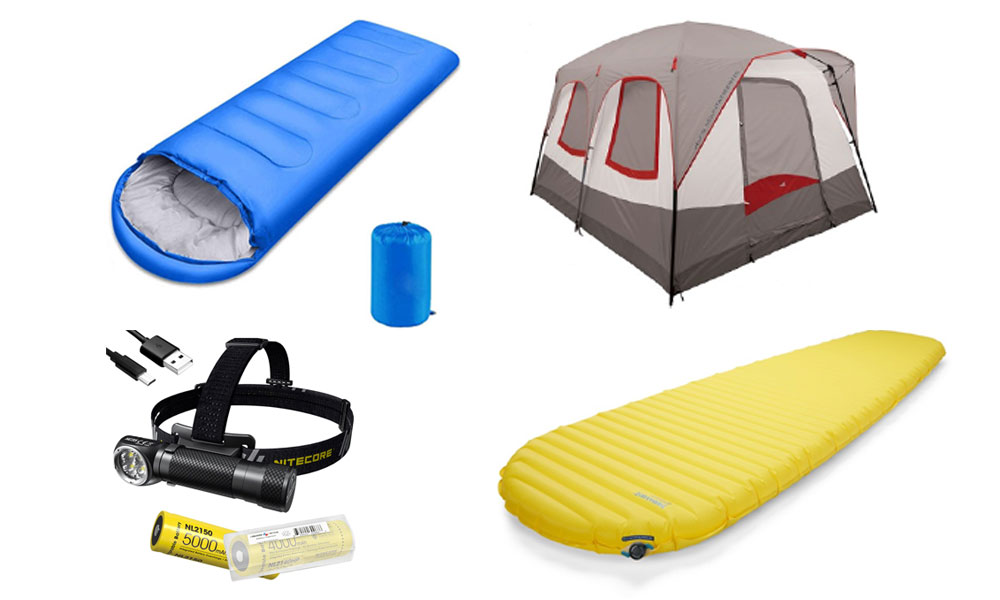
Sleeping Bag
Every trekker must be acknowledged of Everest Base Camp's weather and climate conditions. It is proven that night times are far worse than the day in terms of temperature and weather. The sharp winds, snowfalls, and freezing temperatures make survival very hard.
Since trekkers must get enough sleep after long hours of hiking, they should consider packing weather-friendly sleeping bags. These items should be rated at least -5 to -10 Degrees Celsius to retain enough heat to help you get a good night's sleep. Almost every sleeping bag has characteristics like windproof and waterproof, so it's not a thing to worry about dealing with rainwater and cold winds.
Sleeping Pad
As the temperature in the EBC region is cold, the ground gets even colder. When trekkers set up a camp to stay overnight during the trek, they must find something to sleep over, and sleeping pads are the best one to serve you. Sleeping pad comes with a heat-retaining mechanism. When you keep it as insulin between your body and the ground, the ground's cold will not transfer to your body. It ultimately makes you stay warm and sound.
Similarly, sleeping pads are hygienic and safe and come with great comfort. So body pain and health issues are not to be a thing to worry about.
Headlamp or Flashlight With Extra Batteries
The average hiking time during the Everest Base Camp Trek is 6 to 7 hours. It means that if you start your hike in the morning, you will reach your destination in the evening. While it might be dark in the evening, you need a strong headlamp or flashlight to see the route.
Headlamps are also a medium to get safely to the destination since they provide enough light to navigate through the rugged terrains of the region. Pack extra batteries so your headlamp's life won't go off on the verge of your hike. Besides, headlamps are essential for walking around the tea houses and camps you are staying at night.
Emergency and Safety Equipment: First Aid Kit, Map, and Documents
Sunscreen (SPF 30 or higher) | Sunglasses with UV Protection
Sun Protection materials are must-pack things during the Everest Base Camp Trek. Remember, the sun can be very harsh during the daytime, and the temperature can reach 10 to 15 Degrees Celsius. Though the temperature might not be a big deal to trekkers, the UV Rays can burn your skin. This is why trekkers should consider Sunscreen with more than SPF Level 30 or higher and Sunglasses with UV Protection in their Everest Base Camp Trek packing list. This will help you get away with skin-related issues during the hike.
Personal Medication and First Aid Kit
Trekkers' safety is the most prioritized matter in any trek. Trekkers should be mindful of potential emergencies like injury, altitude sickness, and other natural hazards they might encounter during the trek.
Trekkers must carry safety gear and first aid kits, including bandages, painkillers, antiseptics, antibiotics, thermometers, etc. Similarly, they can carry Diamox to deal with altitude sickness and also remember to pack personal medication if they have any health issues. On top of that, trekkers must consider carrying oxygen supplements if they have problems with exploding to high altitude locations.
Toiletries (toothbrush, toothpaste, wet wipes, hand sanitizer, etc.)
There are limited latrines around the Everest Base Camp trek, so trekkers must prepare toiletries and other items. Items like wet wipes and hand sanitizers should be in your backpack so you can use them hygienically during the trek.
Regarding personal hygiene, you should pack other hygienic items like toothpaste, toothbrush, and other essential materials.
Trekking Map and Guidebook
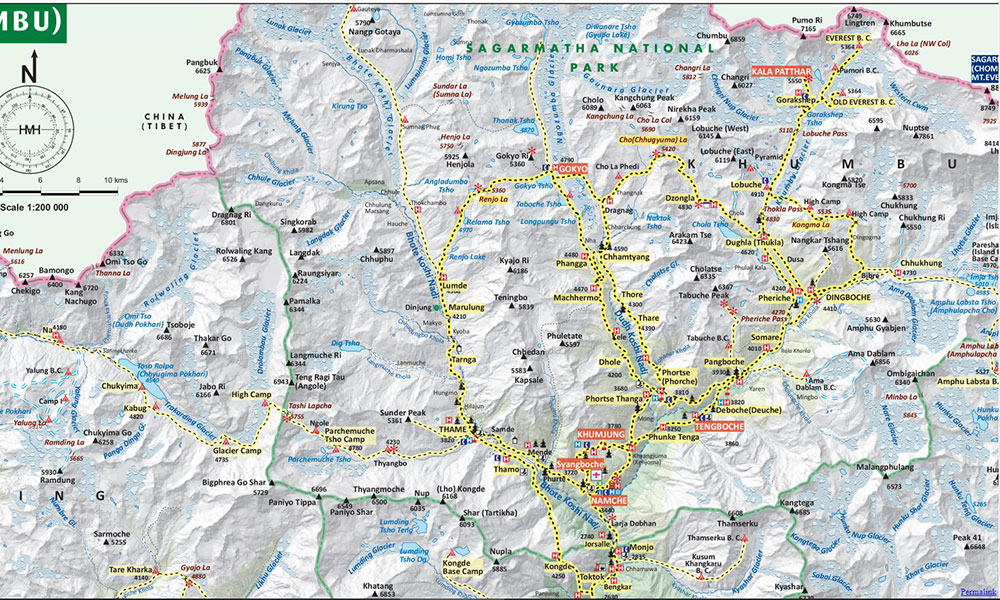
You don't want to get lost in the remote trails of the Everest Base Camp, so carrying maps and guidebooks can help you safely take you to the destination. The trail to EBC passes through the forest areas in the remote Solukhumbu District. After passing Namche Bazaar, the route is rocky and rugged, and the forested areas of this region are rich in wildlife.
Several records of trekkers are missing from this trail, especially those who travel solo. So to deal with the issue, Nepal Government and Nepal Tourism Board has passed a law to hire a professional guide to undertake this trek compulsorily. While you travel with a guide, there is no chance of getting lost; but having a trekking map will let you know where you have reached and which altitude you are at. This helps you prepare for altitude sickness as well.
Cash in Nepalese Rupees for Expenses
It would be best if you carried the local currency while traveling through the locations around Everest Region. There is only Namche Bazaar where you can swipe your card to withdraw money. But if you leave the town behind and trek further ahead, you can only exchange money in cash. That's why you should always carry some cash with you, which can be used for buying snacks, water, and other local materials you may like during the trek.
Passport and Necessary Permits and Documents
There is a place called Monjo where you must go through a legal procedure. If you have not bought the permits for the EBC trek, you can buy them, and if you have already bought them, you may need to show your legal documents, such as copies of valid passports, permits, photographs, and other essential documents.
You may also like:
- Everest Base Camp Helicopter Tour
- Cheap Everest Base Camp Trek
- Everest Panorama Trekking
- Short Everest Base Camp Trek
- Everest Base Camp Luxury Trek
How To Buy/Rent Gears In Nepal?
If you want to buy or rent hiking gear in Nepal, there are several stores to get them. While in Kathmandu, you can surf around Thamel, where you can find these stores that sell high-quality products like hiking boots, trekking poles, backpacks, and other related items.
Buying hiking gear will be wise for frequent trekkers, while it will be good to rent those if you are an occasional traveler. If you buy the gear, it will be yours for your upcoming trekking campaigns. But if you do not trek often, renting these items can save you money, as renting is not as expensive as buying.
The cost of these items varies on the quality. High-quality brands like Northface, Black Diamond, Patagonia, Marmot, and Nimsdai can cost you more than $500, depending on your chosen products. You can also get budget-friendly products but must compromise on their quality.
We suggest you buy quality products as they serve you best regarding safety. Or you can rent these high-quality gear so you don't have to compromise with safety issues.
There are several stores in Thamel where you can buy and rent hiking gear. Some of them are as follows:
- Himalayan Trekking Gear
- Makalu E-Traders
- Kalapatthar Trekking Store
- Mandala Outdoor Gear
- Trekking Gear Nepal
- Himalayan Gear
- Sherpa Adventure Gear
Can I Buy/Rent Hiking Gear In Route to EBC?
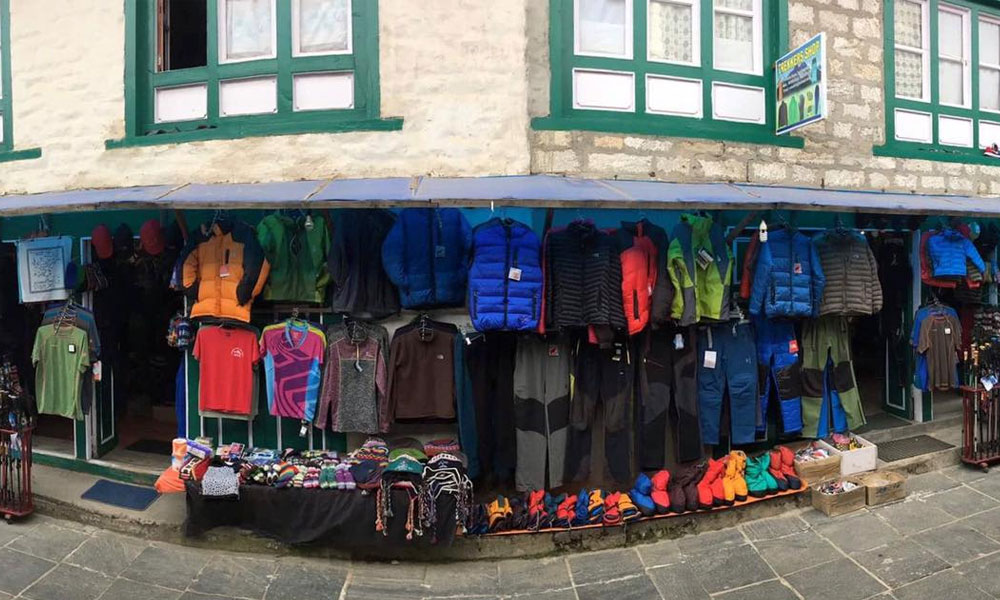
First, you should be already preparing the packing list for Everest Base Camp Trek, which means you should already have purchased your needed gear in Kathmandu. You can still buy or rent the products if you are already in Lukla or Namche Bazaar. Lukla features a variety of shopping stores based on hiking products; you can find both quality and budget-friendly products.
Namche Bazaar also has many stores that deal with the trekking products of your preference. But buying and renting in Namche Bazaar also comes with a compromise. If you are looking forward to purchasing at Namche, you should consider hiking from Lukla to Phakding and Phakding to Namche without quality hiking gear (if you do not have extra). Nevertheless, you can still enjoy the shopping spree at Namche Bazaar, the Gate to Mount Everest.
Should I Hire Guides And Porter?
If you look through the angle of safety, hiring guides and porters is a wise choice. On top of that, the Nepalese Government and Nepal Tourism Board have banned solo trekking to EBC because trekkers are missing and injured while they travel alone.
So to minimize these issues, hiring guides and porters is very fruitful. Guides can lead you through the easy and shortcut ways, and they are more acknowledged with the local environment, people, culture, and lifestyle, which makes you easy to groom to the community. Similarly, guides are always first-hand support if you suffer an injury or undergo medical emergencies.
Similarly, porters carry your packing list for Everest Base Camp, allowing you to delve into the journey and get the most out of it. Carrying your backpack, gear, and other essentials for long hours during the trek is challenging. Here, porters will come of great use and help.

Time of the Year and Packing List for Everest Base Camp
The time of the year you are trekking and the preparation of the packing list for Everest Base Camp has a great relationship. Your packing list should include the essentials that are weather-friendly. For example, your packing list might not be tight if you are trekking in the autumn and spring. Since this is the peak season for EBC Trek, trekkers have to focus more on the logistics. But it does not mean that you need no preparation on gear. Even in the peak season, the weather is unpredictable, and night times are harsher than expected. So having windproof/waterproof gear, sleeping bags, warm clothes, and others are recommended.
Off-season treks are even more dangerous, requiring an extra layer of preparation with gears. The monsoon season brings heavy rainfall, and trekkers require sturdy hiking boots, windproof jackets, and sleeping bags to beat the rain. The slippery routes can be more challenging, so packing trekking poles is necessary.
Besides, the winter season is even harsher: the cold temperatures, sharp winds, and heavy snowfall can make the hike challenging, so packing the gears that can withstand the colder temperatures should be kept in mind.
See also:
- Everest Base Camp Trek Difficulty Level
- Everest Base Camp Trek Map
- Where is the best place to see Mount Everest?
- Is Everest Base Camp Worth Visiting?
Conclusion
Whether you are trekking to EBC in summer, winter, or peak seasons like Autumn and Spring, preparation is always necessary. This means that your packing list for Everest Base Camp should cover everything that can help you be safe in the harsh environment and weather conditions of the Everest Region. Research and take advice from your guide, trekking agencies, and fellow travelers to purchase or rent quality equipment to make this trek more enjoyable and memorable. And for Everest Base Camp Expedition, please do check-out our recommended trek package- Short Everest Base Camp Trek.

